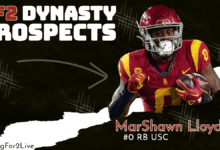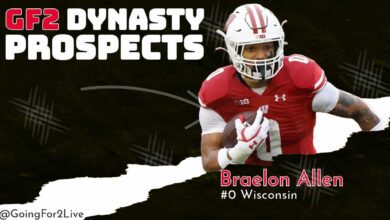
(www.fanthem.com)
(Written by @Infantryboys)
I’m not a pro at Daily Fantasy Sports or anything like that, in fact last season was my first full year of NFL DFS. Heck it wasn’t even a full year as I made my first deposit until week 5. As a newb last year I made every rookie mistake that can be made by someone who played a lot of season long fantasy and thought he knew what he was doing. And by every, I mean EVERY…. I quickly found out that DFS is not easy, but if you know what you’re doing you can have fun and maybe even make a few dollars. Maybe…
Since I’m not overly fond of losing money (and I was losing money my first couple of weeks) I decided to educate myself. I read everything I could about DFS from a variety of sources. I was a pretty quick study though, and my initial deposit on Fan Duel of $50 had grown to over $2000 by the end of the season and I had branched out into DraftKings and a couple of other sites, where I made more rookie mistakes. Still, my total bankroll was about $2500 across various sites by season’s end, and I managed to grow it a bit during NBA and MLB as well.
So in an effort to help a new season of newbs not make the same mistakes I did (I’m philanthropic that way) I put together this list. Experienced players probably won’t need this (since you’re still here and not busted and disgusted) but all you young-uns, pull up a chair and let Uncle Infantryboys tell you a thing or two.

1) Know The Scoring System
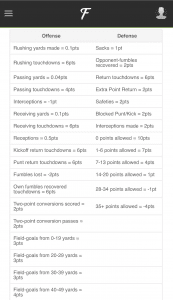
I know this one sounds like a complete “no brainer” but it’s amazing the number of players who really don’t know their sites’ scoring system. How can anyone properly select their players if they don’t know what kind of stats get them points? Yet there they are, picking who they think the “best players” for the week and then wondering why they aren’t cashing.
Sites like Fan Duel have pretty straight forward scoring systems. You get .1 point for every rushing and receiving yard, .025 for every passing yard, 6 points for a rushing/receiving TD, 4 points for a passing TD, etc. FD is also a half PPR site, players get .5 point for every catch they make, etc. Other sites have very different scoring systems. For example Draft Kings awards milestone points for 100 yards rushing, 100 yards receiving and 300 yards passing with a full point awarded for each completion.
Add to these scoring differences the fact that different sites have line up comprised of different positions (some have flex positions, some don’t have kickers and/or defenses) and you can see how your line ups on different sites might look completely different. If you’re playing on different sites, don’t try to shoehorn the same line up into every site. It just doesn’t work. Tailor your line ups to each site’s specific scoring system.
The bottom line here is that if you aren’t completely familiar with the scoring system you’re working with, you’re playing with a severe handicap. You might luck into some wins, but long-term you’re going to lose your bankroll. Before filling out your first line up, take the time to completely familiarize yourself with your site’s scoring system. It will be time well spent.
2) Know Your Contests
Now that you’ve familiarized yourself with your site’s scoring system, the next thing you’ll notice when you enter the lobby is the vast array of contests available to you. Even though it may seem like there are an almost limitless variety of contests all of them boil down to one of two types: cash games and GPPs (guaranteed prize pools). In cash games (50/50s, double-ups and head to head) you only have to be in the top 45-50% to win, where as in GPPs you have to be in the top 15-20% to win money and in the top 2% to win and serious money.
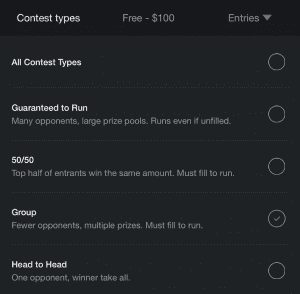
Cash games are all about finding players with high “floors,” or minimum expected performances, and fitting them in under the salary cap. Players with high floors are usually the guys who don’t have huge games but usually don’t have bad games, either. Receivers who catch a lot of passes, but don’t have high yards per catch totals, or running backs who get a lot of carries but aren’t break away threats, are examples of players with high floors. Target these players in your cash games and safely avoid the boom or bust guys.
In GPPs, finishing in the 30th percentile will do you no good, so you have to be much more daring when constructing your line ups. Therefore you’ll want to target players with high “ceilings” in GPPs or players that have the ability to have big games. Often times these are boom or bust sort of players, but if they bust, oh well, finishing in the 25th percentile does you as much good as finishing in the 95th. Typically you’ll want to target players with high upside, who may not get as many chances in games as your GPP targets (WRs with high yards per reception but not as many receptions, break away runners, etc.)
Typically I’ll build one cash game line up and two or three GPP line ups. Others play almost exclusively cash games while other do the opposite and play only GPPs. Find out what types of contests best suit you, there really isn’t a right or wrong here. Just do yourself one favor here, always put your cash line up in a GPP. If it explodes and you finish first in a 500 man $5 double-up, you’ll still only win that $5, whereas it could have won you several hundred in even a $1 GPP. Believe me, if this happens to you, it’ll haunt you for a while.
Love our content? Check out the GoingFor2 Live Podcast Network!
3) Running QBs are Cash Game Gold
This is going to be a shorter Commandment (“thankfully”, I hear you cry) but one that I have profited from immensely. Therefore I think this brief discussion merits its own section, due to how having a running QB benefits a cash game line up.
As we discussed earlier, in cash games we are looking for a high floor. Most new fantasy players think of QB fantasy production as merely passing yards and passing TDs. This is a mistake. While it’s true QBs derive most of their fantasy points from these stats, you’re missing a great deal of production if you ignore QBs rushing stats.
Let me give you some examples. In 2014, Russell Wilson rushed for 849 yards and 6 TDs and in 2012 Cam Newton rushed for 706 yards and 14 TDs. In standard scoring, Wilson’s legs got him an additional 120.9 points over the course of the season or 7.56 points per game and Newton got an outstanding 154.6 and 9.66 points per game out of the run. Furthermore these two were never overpriced due to the fact they didn’t have the huge upside of a Aaron Rodgers or Peyton Manning.
Now I’m not saying always take a running QB in cash games (or ignore them in GPPs, last season I won $825 in a $3 buy in with Wilson as my QB in two GPPs), match ups play a huge roll, but these QBs always get a bump that non-running QBs don’t.
4) Targets and Touches
Targets and touches simply refer to how many times a game a QB throws to a certain receiver or back (targets) or how many times a back touches the ball (touches.) WRs and TEs, and to a lesser extent RBs, are very dependent on their QB for their fantasy points and this stat measures how many times the players get a chance to rack up points. All things being equal, the more time a WR or TE is targeted, the better and opportunity that player has to get points.
Many inexperienced DFS players will allow the last week’s performance, or the last few weeks, to overly influence their player selection. This can be dangerous. Let’s say we have a WR who caught 9 passes for 200 yards and three TDs the last two weeks, who’s now facing a decent match-up. Many will roster this player automatically, but if we dig deeper, we might see he was only targeted 6 times in each game. Eventually his stats will regress to the mean at this target rate. In other words, he made the most of his chances the last two weeks, but eventually this low target rate means he’ll have a clunker soon. Add to this the fact that his price probably went up in the wake of these performances and this is a player, I’ll be fading.
This same line of thinking holds true for running back. If a RB got 10 touches (8 carries and two catches) and got 110 yards and two TDs, this level of production is not sustainable and soon, his stats will regress to the mean. Let others throw away their money hoping for a repeat performance.
Finally, since the NFL teams only play 16 games a year, there isn’t a lot of data to go on, especially at the beginning of the season. Therefore, we have to go deep in our research. For example, in week 3 we notice a normally productive and highly targeted receiver isn’t getting many targets. Instead of automatically fading him, we dig deeper and discover his first two opponents were the Jets and Seahawks and we was covered by Revis and Sherman. This week he’s facing a week secondary and will be covered by a rookie CB. That’s a great opportunity to buy low, as most people would discount this receiver based on his first two weeks’ worth of stats.
Incorporate touches and targets into your research. It will pay dividends.
[wysija_form id=”1″]5) How And Where To Find Value
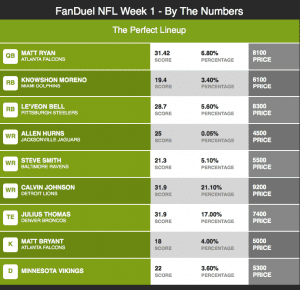
As I’m sure you’re aware, or you will be aware shortly, NFL DFS incorporates a salary cap, so you can’t roster all the stud players you want. In order to be successful, you’ll have to find some cheaper players to fill out your line ups. Cheaper players, in good positions to perform well are what is known as “value” and are fantasy gold.
The best way to find value is when back-ups assume starting roles due to injury or the benching of starters. This is especially true when the injuries or benchings occur mid-week, that way the sites haven’t adjusted the salaries of these players. If you recall last season when Cam Newton was injured in a traffic accident mid-week, his back-up Derek Anderson became a great value play as his salary was at a minimum. This is the type of situation we’re looking for in NFL DFS.
Another great way to find value is through opponent’s’ injuries. If a team is playing an opponent with several key defensive injuries, their skill players might suddenly become great value. Conversely, if a starting QB is replaced by an inexperienced rookie, an average defense might become a great value play.
Another way that you can find value, and you have to dig a little bit for this one, is finding players who have been under-performing recently due to tough match ups. As I mentioned earlier, most daily fantasy players are victims of the moment. They tend to over react to recent performances. Players that have had below average recent games, due to poor match ups or game flow (RBs’ stats tend to suffer when the team gets out to an early deficit, for example) are usually underpriced and low owned.
If you’re going to be successful at DFS, in any sport, you’re going to have to find low priced players to fill out your line ups. Make sure they’re value picks and not just dart throw and Hail Mary’s.
6) Know Your Research Sites
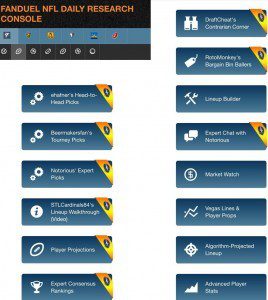
If you haven’t figured it out by now, successful DFS players do a lot of research before filling out their line ups. The beauty of NFL is that you have all week to do this research as opposed to having to cram it into one day for NBA or MLB. Still, you want to maximize your time and use the most effective research tools. I’ll share my favorite sites and methods of research, but keep in mind there are countless other site and tools out there at your disposal.
My go to research site is the very site we’re on right now, Rotogrinders. If you click the “Daily Research” tab, you’ll find a wealth of free information at your fingertips. One of my favorite tools is “Defense vs Position.” This is a great place to start as you can use it to determine which players have the best match-ups based on recent or season long performance. Another tool I use is “Trending Stats Watch.” I use this tool to determine which players are “hot” or simply are getting more touches and targets, There are several other valuable tools on this site and familiarizing yourself with them is invaluable.
While Rotogrinders has some great research tools, it not the only site I use. One of my favorite sites is Football Outsiders, in particular their “Defensive Efficiency Ratings” and their “Defense vs Type of Receiver.” The Defensive efficiency rating offers every team’s defensive rankings against the run, against the pass and lets who know which teams are most consistent defensively. These stats are also weighted based on opponents. This tool gives you a great idea on which defenses to avoid and which ones to target. The defense vs type of receiver tool allows you to see what defenses are weak or strong versus types of receivers (#1 WR, #2 WR, TE, etc.) I also find this very valuable; just because a team ranks highly in pass defense, for example, maybe they struggle against TEs. This tool allows me to hone in on which receivers I target every week.
Beginning in training camp, you’ll also want to read RotoWorld every day. The 10-15 minutes a day, the time you spend doing this will be time well spent. RotoWorld has a wealth of information, everything from injury updates to coach’s remarks about players and schemes. This allows you to track injury situations of skill and non-skill players (if a team’s top two linemen are hurt, you might consider fading the RB), see which players may be getting more snaps and which players may be in the doghouse. Stats are the life blood of DFS, but if a coach wants to bench a player, his previous stats don’t matter.
Different people use different research sites and methods. Find what works for you but always open yourself up to acquiring as much information as possible before filling out your line ups.
7) Use Vegas To Help You
Unless you’ve been living in a bubble, you know that the various sports books in Las Vegas publish odd and take action on practically every sporting event in the world. Every week you’ll see a point spread and a over/under on every NFL game. Rotogrinders U publishes a great section on using Vegas, so I won’t rehash or plagiarize that here, I’ll just share with you how I use the Vegas odds and how they’ve benefitted me in NFL DFS.
As I’m sure you’re aware, Vegas publishes two sets of odds for every NFL game; a point spread and an over/under. I’ve found both sets of odds extremely useful in my research to the point that I would never consider rostering a line up with consulting both of these.
The O/U odds are extremely useful in targeting games that are expected to be high scoring. The players in these games should definitely see a bump. When paired with the point spread, the O/U allows you to see the predicted final score of each game. Obviously, you want to target offensive players from high scoring games and defenses in low scoring games.
I tend to try to roster QBs and WRs/TEs from high O/U games where the team is a underdog on the Vegas line. Why do I do this? It’s simple. The team that’s the underdog in a high scoring game should still be throwing at the end of the game, giving a bump to the QB and the receivers. They’ve already scored a lot of points, but they have to get more to win the game. Conversely, RBs from teams predicted to win high scoring, close games, should be targeted since these teams are trying to run out the clock. As with everything in DFS, these are not hard and fast rules, but more tools to use when filling out your line ups.
8) Track Offseason Player and Coaching Moves
OK, most NFL fans are aware of the big name player moves, especially the skill position guys we track the most, in fantasy sports. This is a good start, but we have to dig much deeper into these moves, especially if we’re to get an edge in the early season games.
I’ll give you an example here. The Eagles signed rushing champion DeMarco Murray; we all know this. If we do a little research we find that the Cowboys, Murray’s old team, had the #1 ranked offensive line last year and the Eagles were ranked #3, so on the surface, Murray should pick up where he left off. Not quite. We did a little deeper and we find that the Eagles lost BOTH of their starting guards and they also signed RB Ryan Mathews, who will siphon carries from Murray. Therefore, I’m downgrading Murray to begin the season.
We also want to track defensive signings. Last season the Jets had a strong front seven, but we targeted their weak pass defense in DFS. In the offseason they shored that pass defense up by signing Darrelle Revis and Antonio Cromartie, two elite cornerbacks. Therefore not only am I not going to be targeting QBs and WRs versus the Jets, the Jets defense will get a huge bump in their early season match ups.
Finally, we can’t just track player movements, but we need to track coaches, especially coordinators who design the game plans, as well. I’ll give you a couple of examples. Marc Trestman, one of the most pass happy coaches in the NFL, is the new offensive coordinator in Baltimore. Therefore I’m giving Joe Flacco and the Ravens’ receivers a bump in my evaluations. Meanwhile, Kyle Shanahan is the new offensive coordinator in Atlanta. His trademarks are a strong running game and heavy use of the X receiver. Therefore, I’ll give a bump to whoever wins the running back battle as well as Julio Jones, the Falcons X receiver. The other Falcons receivers will get a corresponding downgrade.
9) Kickers And Defenses Are Not A Complete Crap Shoot
There are many DFS players who believe defenses, and especially kickers, are completely random, so they roster cheap defenses and the cheapest kicker in an effort to save salary for their offensive players. While we never want to over pay for any position, this strategy is a mistake, in my opinion. Kickers and defense are often the difference between a big GPP cash and not cashing at all. For example last season the Rams had back to back 32 and 27 point games in weeks 13 and 14. If you wanted to place high in a GPP, you needed to have the Rams defense.
When it comes to selecting a defense, you’ll need to understand the scoring system (Commandment #1.) The vast majority of DFS sites reward sacks, turnovers and TDs far more than scoring. Therefore we want to target offenses that turn the ball over and allow a lot of sacks. The easiest way to do this for me is to simply target rookie QBs and inexperienced back-ups playing for injured starters. These QBs are more turn over prone and they tend to hold the ball longer, leading to more sacks. As the season progresses, we can research what offense to target based on recent performance, but in the early season we don’t have these stats at our disposal. Of course I’ll also use Vegas to target low scoring games.
While its true kickers are the most random position to select in DFS, if you’re playing on a site that has the kicker position, there are ways to maximize your chances of rostering the right one. I give a bump to kickers playing in domes, since they won’t have to deal with any negative weather conditions and they’ll be kicking off of turf. I’ll also use Vegas to target kickers whose teams are favorites in high scoring games. I target the favorites because they’ll be more likely to pad their lead with a field goal than a team coming from behind, who may have to score TDs and “go for it” on 4th down, rather than kick a FG..
Remember, don’t over pay for these positions but don’t blow them off either. Every point in NFL DFS is valuable and a great performance by your defense or kicker can pay off big.
10) Game Starts Effect Ownership And Other Subtleties
The last thing I’m going to hit on in this article are some of the subtle nuances of NFL DFS that are often overlooked by inexperienced players. Using these techniques can be a way of separating yourself from the field in the competitive DFS environment.
All things being equal, you want your players to be low owned, especially in GPPs, since if they score well, you’ll be higher on the leaderboard. In cash games ownership levels aren’t a big deal, since you’re not trying to win the contest, you’re trying to be in the top 50%. One thing that I’ve noticed is that the players in the earlier games are always over owned. If you’re playing a Thursday-Monday slate, fade the Thursday players in your GPP contests. They’re always heavily owned, since many people want to see their players racking up points immediately or see themselves on the first page of the leaderboard.
Another thing, it’s a mistake to ignore is weather in NFL DFS. No, this isn’t MLB where games get rained out, and games rarely get postponed in the NFL, but rain and wind do affect player performances. While cold weather has no significant effect on player performance, other elements do. Make sure to check weather reports prior to game starts and downgrade players who are expected to play in bad weather. High wind negatively affects QBs and receivers, while heavy rain negatively affects all offensive players. Take weather into consideration when finalizing your line ups.
The last thing I’ll leave you with is this; “name” players tend to be higher priced on most DFS sites. Casual fans tend to gravitate to these players and they tend to be higher priced because of this. Even if these star (or former star) players are slumping or past their prime, their price tends to be higher than that of lesser known players. I’m not telling you to avoid stars when setting your line ups, just incorporate this fact into your research.
And there you have it, the 10 Commandments of NFL DFS. I wish you all a prosperous and profitable NFL season.
ATTN Dynasty Commissioners: Do you want to do something cool for your league? How about a 1-hour live show dedicated to YOUR league? Team-by-team breakdowns, rankings, and more. For details and to book a show, visit: GoingFor2.com/plp.

